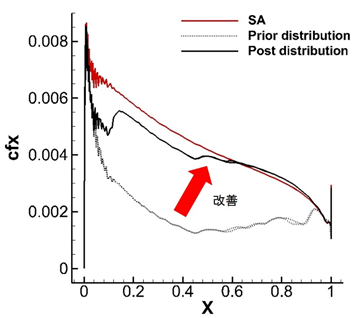Innovation for Design, Data-acquisition, Trouble-shoot and Certification in Aircraft Development: Basic Techniques for Real Flight Prediction
JAXA Supercomputer System Annual Report April 2016-March 2017
Report Number: R16E0034
- Responsible Representative: Takeshi Ito(Aeronautical Technology Directorate, Next Generation Aeronautical Innovation Hub Center)
- Contact Information: Kazuyuki Nakakita(nakakita@chofu.jaxa.jp)
- Members: Kazuyuki Nakakita, Shunsuke Koike, Shigeru Kuchiishi, Kanako Yasue, Hiroshi Kato, Mitsuhiro Murayama, Kentaro Tanaka, Tohru Hirai, Yasushi Ito, Keita Hatanaka, Takashi Misaka, Hiroya Toriida
- Subject Category: Aviation(Aircraft)
Abstract
As a series of real flight prediction techniques, we try to develop a basic method which adjusts the parameters of the transition model in CFD analysis from the observed data using the data assimilation technique.
Goal
In order to realize speed-up of the aircraft development, we establish up-to-date basic techniques which can be applied to enhance efficiency of the R&D process for the domestic aircrafts.
Objective
In producing aerodynamic model, we shift the method of aerodynamic prediction from the experimental/empirical to analytic approach and make it possible to predict the real flight condition both precisely and efficiently, and consequently to minimize the risk in the development process of domestic aircraft.
References and Links
N/A
Use of the Supercomputer
To realize the fluid analyses of numerous samples.
Necessity of the Supercomputer
There is no environment to perform the fluid analyses of numerous samples under realistic time.
Achievements of the Year
A highly accurate estimation method of turbulent transition phenomena, which is difficult to measure, by integrating fluid analysis results of large samples and the measurement result of the wind tunnel experiment with the data assimilation technology was proposed. Fig. 1 shows the result of examining the effectiveness of the proposed method by numerical experiment.
Publications
N/A
Computational Information
- Parallelization Methods: Process Parallelization
- Process Parallelization Methods: MPI
- Thread Parallelization Methods: n/a
- Number of Processes: 64
- Number of Threads per Process: 8
- Number of Nodes Used: 1
- Elapsed Time per Case (Hours): 0.02
- Number of Cases: 192
Resources Used
Total Amount of Virtual Cost(Yen): 26,832,862
Breakdown List by Resources
| System Name | Amount of Core Time(core x hours) | Virtual Cost(Yen) |
|---|---|---|
| SORA-MA | 16,219,323.48 | 26,468,392 |
| SORA-PP | 20,225.18 | 172,682 |
| SORA-LM | 117.58 | 2,645 |
| SORA-TPP | 0.00 | 0 |
| File System Name | Storage assigned(GiB) | Virtual Cost(Yen) |
|---|---|---|
| /home | 64.27 | 602 |
| /data | 10,941.59 | 102,719 |
| /ltmp | 7,467.61 | 69,987 |
| Archiving System Name | Storage used(TiB) | Virtual Cost(Yen) |
|---|---|---|
| J-SPACE | 5.17 | 15,832 |
Note: Virtual Cost=amount of cost, using the unit price list of JAXA Facility Utilization program(2016)
JAXA Supercomputer System Annual Report April 2016-March 2017



